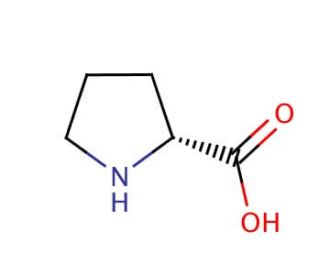
Click on image or enlarge button to enlarge

D-Proline: sc-255062
D-Proline (CAS 344-25-2)
Alternate Names:
(R)-Pyrrolidine-2-carboxylic acid
CAS Number:
344-25-2
Molecular Weight:
115.13
Molecular Formula:
C5H9NO2
For Research Use Only. Not Intended for Diagnostic or Therapeutic Use.
* Refer to Certificate of Analysis for lot specific data.
QUICK LINKS
Ordering Information
Description
Technical Information
Safety Information
SDS & Certificate of Analysis

D-proline is a crucial amino acid in the realm of biochemistry. As an isomer of the more prevalent L-proline, it occurs in proteins in small quantities. D-proline finds diverse applications in scientific research. In vitro, it has served as a substrate in enzymatic assays, a model compound for investigating protein-ligand interactions, and a model compound for studying enzyme kinetics. Additionally, D-proline serves as a valuable chiral auxiliary in organic synthesis. The specific mechanism of action of D-proline varies depending on its application. In asymmetric synthesis, it functions as a chiral auxiliary, creating a chiral environment for the reaction. In enzyme-catalyzed reactions and enzyme assays, it acts as a substrate, providing a source of energy for the reactions. In the context of protein-ligand interactions, it serves as a model compound, offering insights into the interplay between proteins and ligands.
References:
- Determination of free D-proline and D-leucine in the brains of mutant mice lacking D-amino acid oxidase activity. | Hamase, K., et al. 2001. Anal Biochem. 298: 253-8. PMID: 11700980
- Dye-linked D-proline dehydrogenase from hyperthermophilic archaeon Pyrobaculum islandicum is a novel FAD-dependent amino acid dehydrogenase. | Satomura, T., et al. 2002. J Biol Chem. 277: 12861-7. PMID: 11823469
- L-Serine, D- and L-proline and alanine as respiratory substrates of Helicobacter pylori: correlation between in vitro and in vivo amino acid levels. | Nagata, K., et al. 2003. Microbiology (Reading). 149: 2023-2030. PMID: 12904542
- The presence of free D-alanine, D-proline and D-serine in mice. | Nagata, Y., et al. 1992. Biochim Biophys Acta. 1115: 208-11. PMID: 1346751
- Intracerebroventricular injection of L-proline and D-proline induces sedative and hypnotic effects by different mechanisms under an acute stressful condition in chicks. | Hamasu, K., et al. 2010. Amino Acids. 38: 57-64. PMID: 19023642
- Proline racemases: insights into Trypanosoma cruzi peptides containing D-proline. | Coatnoan, N., et al. 2009. Mem Inst Oswaldo Cruz. 104 Suppl 1: 295-300. PMID: 19753488
- L- and D-proline adsorption by chiral ordered mesoporous silica. | Casado, C., et al. 2012. Langmuir. 28: 6638-44. PMID: 22475019
- D-amino acid aberrations in cerebrospinal fluid and plasma of smokers. | Luykx, JJ., et al. 2013. Neuropsychopharmacology. 38: 2019-26. PMID: 23615666
- D-Amino acid oxidase and presence of D-proline in Xenopus laevis. | Soma, H., et al. 2013. Comp Biochem Physiol B Biochem Mol Biol. 166: 165-71. PMID: 23994361
- D-Glutamate is metabolized in the heart mitochondria. | Ariyoshi, M., et al. 2017. Sci Rep. 7: 43911. PMID: 28266638
- Mouse d-Amino-Acid Oxidase: Distribution and Physiological Substrates. | Koga, R., et al. 2017. Front Mol Biosci. 4: 82. PMID: 29255714
- Merging Visible Light Photocatalysis and l-/d-Proline Catalysis: Direct Asymmetric Oxidative Dearomatization of 2-Arylindoles To Access C2-Quaternary Indolin-3-ones. | Dong, CL., et al. 2020. Org Lett. 22: 1076-1080. PMID: 31975600
- D-Amino acids in mammalian endocrine tissues. | Chieffi Baccari, G., et al. 2020. Amino Acids. 52: 1263-1273. PMID: 32930873
- Microbial Proline Racemase-Proline Dehydrogenase Cascade for Efficient Production of D-proline and N-boc-5-hydroxy-L-proline from L-proline. | Zhang, F., et al. 2022. Appl Biochem Biotechnol. 194: 4135-4146. PMID: 35635604
- d-Proline Reductase Underlies Proline-Dependent Growth of Clostridioides difficile. | Johnstone, MA. and Self, WT. 2022. J Bacteriol. 204: e0022922. PMID: 35862761